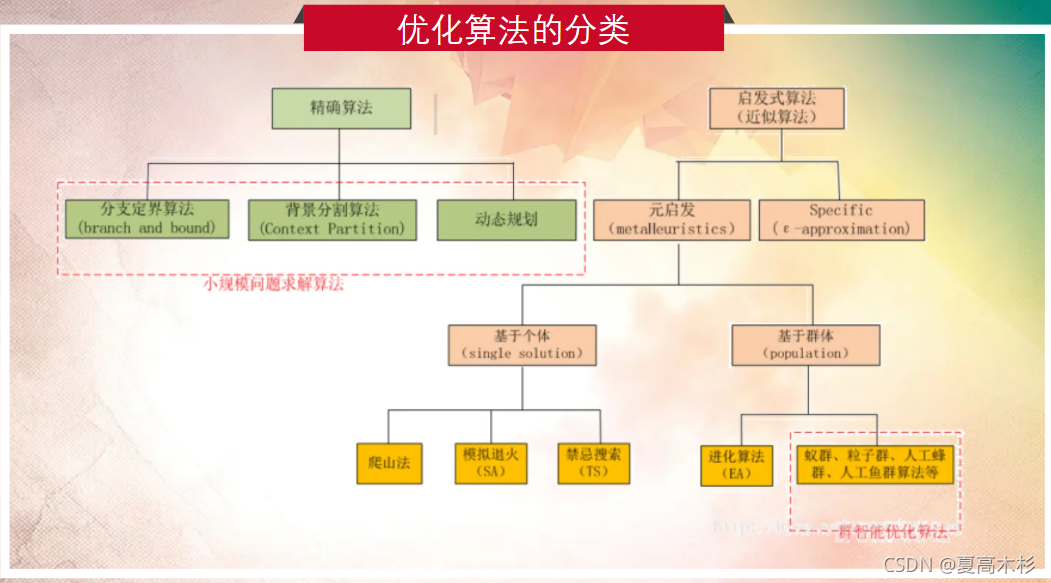机器学习中的模拟退火算法:提升模型性能的秘密武器
发布时间: 2024-08-24 20:57:29 阅读量: 64 订阅数: 29 


机器学习-模拟退火算法-全局最优解-全局优化算法

# 1. 模拟退火算法概述
模拟退火算法是一种受物理退火过程启发的优化算法。它模拟了固体材料在冷却过程中能量降低的过程,以找到复杂问题的高质量解决方案。该算法通过以下步骤工作:
- **生成初始解:**算法从一个随机解开始。
- **计算解的能量:**能量函数衡量解的质量。
- **生成邻域解:**算法通过对当前解进行随机扰动来生成邻域解。
- **计算邻域解的能量:**算法计算邻域解的能量。
- **接受或拒绝邻域解:**如果邻域解的能量低于当前解的能量,则接受它。否则,根据概率接受它,该概率随着算法的进行而降低。
- **重复步骤 2-5:**算法重复这些步骤,直到达到停止条件(例如,最大迭代次数或能量变化低于阈值)。
# 2. 模拟退火算法在机器学习中的应用
模拟退火算法在机器学习领域有着广泛的应用,主要体现在模型优化和特征选择两个方面。
### 2.1 模型优化
模拟退火算法可以有效地优化机器学习模型的超参数和神经网络的训练过程。
#### 2.1.1 超参数调优
超参数调优是机器学习中至关重要的一步,它决定了模型的性能。模拟退火算法可以搜索超参数空间,找到最优的超参数组合。
```python
import numpy as np
import random
def simulated_annealing(objective_function, initial_solution, max_iterations, cooling_rate):
"""
模拟退火算法
参数:
objective_function: 目标函数
initial_solution: 初始解
max_iterations: 最大迭代次数
cooling_rate: 冷却速率
"""
current_solution = initial_solution
best_solution = current_solution
best_score = objective_function(current_solution)
for i in range(max_iterations):
# 产生邻域解
neighbor_solution = generate_neighbor(current_solution)
# 计算邻域解的得分
neighbor_score = objective_function(neighbor_solution)
# 计算接受概率
delta_score = neighbor_score - current_score
acceptance_probability = np.exp(-delta_score / cooling_rate(i))
# 接受或拒绝邻域解
if acceptance_probability > random.random():
current_solution = neighbor_solution
current_score = neighbor_score
# 更新最佳解
if current_score > best_score:
best_solution = current_solution
best_score = current_score
# 冷却温度
cooling_rate(i)
return best_solution
```
**逻辑分析:**
* 该代码块实现了模拟退火算法。
* `objective_function` 是目标函数,用于评估解的质量。
* `initial_solution` 是初始解。
* `max_iterations` 是最大迭代次数。
* `cooling_rate` 是冷却速率函数,用于控制算法的探索和收敛行为。
* 算法通过生成邻域解、计算接受概率和更新当前解和最佳解来迭代搜索最优解。
#### 2.1.2 神经网络训练
模拟退火算法也可以用于训练神经网络。它可以优化神经网络的权重和偏差,以提高模型的准确性和泛化能力。
```python
import tensorflow as tf
def train_neural_network(model, train_data, epochs, cooling_rate):
"""
使用模拟退火算法训练神经网络
参数:
model: 神经网络模型
train_data: 训练数据
epochs: 训练轮数
cooling_rate: 冷却速率
"""
# 初始化权重和偏差
weights = tf.Variable(tf.random.normal([784, 10]))
biases = tf.Variable(tf.random.normal([10]))
# 训练循环
for epoch in range(epochs):
# 遍历训练数据
for batch in train_data:
# 前向传播
logits = tf.matmul(batch, weights) + biases
predictions = tf.nn.softmax(logits)
# 计算损失
loss = tf.reduce_mean(tf.nn.softmax_cross_entropy_with_logits(logits=logits, labels=batch))
# 优化权重和偏差
optimizer = tf.train.GradientDescentOptimizer(cooling_rate(epoch))
train_step = optimizer.minimize(loss)
# 执行训练步骤
model.run(train_step)
# 返回训练后的模型
return model
```
**逻辑分析:**
* 该代码块实现了使用模拟退火算法训练神经网络。
* `model` 是神经网络模型。
* `train_data` 是训练数据。
* `epochs` 是训练轮数。
* `cooling_rate` 是冷却速率函数。
* 算法通过初始化权重和偏差、遍历训练数据、计算损失、优化权重和偏差以及执行训练步骤来迭代训练神经网络。
### 2.2 特征选择
模拟退火算法还可以用于特征选择,包括变量选择和降维。
#### 2.2.1 变量选择
变量选择是选择与目标变量最相关的特征的子集。模拟退火算法可以搜索特征空间,找到最优的特征组合。
```python
import pandas as pd
def feature_selection(data, target, max_features):
"""
使用模拟退火算法进行变量选择
参数:
data: 数据集
target: 目标变量
max_features: 最大特征数量
"""
# 初始化特征子集
selected_features = []
# 训练循环
for i in range(max_features):
# 产生邻域特征子集
neighbor_features = generate_neighbor(selected_features)
# 计算邻域特征子集的得分
neighbor_score = evaluate_
```
0
0





